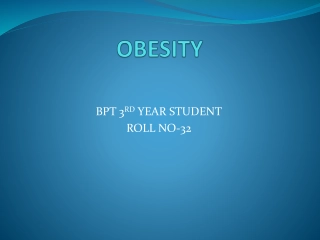Obesity Epidemic in the USA and Global Trends
The USA faces one of the highest obesity rates globally, with two out of every three Americans considered overweight or obese. Obesity is classified based on BMI, and rates have been on the rise in OECD countries. However, recent data shows a slower pace of increase in some countries. Child obesity trends are also a concern.
Download Presentation

Please find below an Image/Link to download the presentation.
The content on the website is provided AS IS for your information and personal use only. It may not be sold, licensed, or shared on other websites without obtaining consent from the author.If you encounter any issues during the download, it is possible that the publisher has removed the file from their server.
You are allowed to download the files provided on this website for personal or commercial use, subject to the condition that they are used lawfully. All files are the property of their respective owners.
The content on the website is provided AS IS for your information and personal use only. It may not be sold, licensed, or shared on other websites without obtaining consent from the author.
E N D
Presentation Transcript
OBESITY AND OVERWEIGHT Obesity is a medical condition in which excess body fat has accumulated to the extent that it may have a negative effect on health, leading to reduced life expectancy and/or increased health problems. BMI is defined as the subject's weight divided by the square of their height and is calculated as follows. where m and h are the subject's weight and height respectively. BMI: m h
BMI (kg/m2)Classification up to18.5: underweight from18.5 to 25.0: normal weight From 25.0 to 30.0: overweight From 30.0 to 35.0: class I obesity From 35.0 to 40.0: class II obesity From 40.0: class III obesity
USA: the highest obesity rates in the world Obesity rates in US are among the highest in the world. Obesity has continued to grow in USA. Two out of every three americans are considered to be overweight or obese. During the early 21st century, America had the highest percentage of obese people in the world.
USA and the other countries Until 1980, fewer than one in ten people were obese in OECD countries. In the following decades, rates doubled or tripled and are continuing to grow. Across the OECD, 18% of the adult population are obese. More than one in three adults in Mexico, New Zealand and the United States, and more than one in four in Australia, Canada, Chile and Hungary are obese. In contrast, rates are just 2 to 4% of adults in Asian countries. Rates grew rapidly in Australia, England and the United States since the 1990s, while they grew at a slower pace in other countries.
New data from ten OECD countries confirm that the obesity epidemic has not stopped spreading. However, a slightly more positive note is that rates have been increasing at a slower pace in the past five years than previously seen. Overweight (including obesity) rates have almost stabilised in Italy, England and the United States, and have grown modestly in Canada, Korea and Spain, in the past ten years. France is the only country where overweight rates have increased more than projected in 2010. Growth continues to be robust also in Mexico, Australia and Switzerland.
SOURCES OECD: the Organisation for Economic Co- operation and Development JAMA: The Journal of the American Medical Association CDCP: the Centers for Disease Control and Prevention























